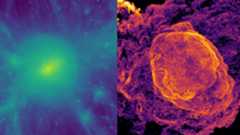Asteroid Miners' Arkyd-6 Satellite Aces Big Test in Space
When you purchase through links on our site, we may earn an affiliate commission.Here’s how it works.

Some of Planetary Resources' asteroid-mining tech just passed a major space test.
The Washington-based company's tiny Arkyd-6 satellite has completed all its mission goals in Earth orbit, just three months afterlifting off atop an Indian rocket, Planetary Resources representatives said.
"The spacecraft successfully demonstrated its distributed computing system, communications, attitude-control system, power generation and storage with deployable solar arrays and batteries, star tracker and reaction wheels, and the first commercial mid-wave infrared (MWIR) imager operated in space," Planetary Resources President and CEO Chris Lewickiwrote in an update Tuesday (April 24).
Best picks for you


The cereal-box-size Arkyd-6 launched on Jan. 12 atop a Polar Satellite Launch Vehicle, along with several dozen other payloads. The cubesat set up shop in a sun-synchronous polar orbit, where it's been working to prove out technology required for Planetary Resources' next spacecraft, an asteroid prospector known as Arkyd-301.
The MWIR imager is particularly important to Arkyd-301 development and to the company's overall goals. The instrument can detect water, which is whatPlanetary Resources will be going after on asteroids, at least at first.
Water can be split into its constituent parts, hydrogen and oxygen, the chief components of rocket fuel. Asteroid mining should therefore lead to the construction and operation of off-Earth propellant depots, which could revolutionize spaceflight and exploration by allowing spaceships to top up their fuel tanks on the go, Planetary Resources representatives and other space-mining advocates have said.
If all goes according to plan, the company will launch multiple Arkyd-301 spacecraft atop a single rocket in 2020. Each spacecraft will cruise to a different asteroid, then assess the space rock's resource potential using onboard instruments such as the MWIR imager. The Arkyd-301s will also carry piggyback miniprobes, which will deploy from their motherships and burrow into their target asteroid to get even closer looks at the space rocks.
Breaking space news, the latest updates on rocket launches, skywatching events and more!
Follow Mike Wall on Twitter@michaeldwall andGoogle+. Follow us@Spacedotcom,Facebook orGoogle+. Originally published onSpace.com.

Michael Wall is a Senior Space Writer with Space.com and joined the team in 2010. He primarily covers exoplanets, spaceflight and military space, but has been known to dabble in the space art beat. His book about the search for alien life, "Out There," was published on Nov. 13, 2018. Before becoming a science writer, Michael worked as a herpetologist and wildlife biologist. He has a Ph.D. in evolutionary biology from the University of Sydney, Australia, a bachelor's degree from the University of Arizona, and a graduate certificate in science writing from the University of California, Santa Cruz. To find out what his latest project is, you can follow Michael on Twitter.
























